Matthew Houde's Blog, page 31
November 4, 2015
Costa Rica Honeymoon Itinerary
Two Weeks in Costa Rica |
Romantic sunsets, picturesque beaches, and gorgeous weather are just a few of the things that make Costa Rica a perfect honeymoon destination. Couple that with lush rainforest and plenty of adventure, and you have the makings for a trip that you and your partner will never forget. In this honeymoon itinerary, we’ll help you pick destinations and activities that will turn up the romance all while showing you the best of what Costa Rica has to offer.

One Week Costa Rica Honeymoon Itinerary
Arriving in Costa Rica
For this itinerary, Liberia International (LIR) in northwestern Costa Rica is the most convenient airport. However, if you find that flights are less expensive into Costa Rica’s main airport in San Jose (SJO), that’s fine too. You may just need to plan on spending the night near the airport at the end of your trip since San Jose is quite far from the Guanacaste beach towns we recommend below. Tip: If you need to stay overnight, we recommend Hotel Buena Vista for a romantic night in the city. This boutique hotel is set very privately on a hill so is nice and quiet and enjoys great views of the cityscape at night.
Days 1-4: Head to La Fortuna, home of the country’s most famous hot springs.
What’s more romantic than soaking in natural hot springs surrounded by lush tropical rainforest?
The first stop for post-wedding bliss is definitely La Fortuna in the rolling hills of northern Costa Rica. This quaint town is most famous for having an active volcano called Arenal, which heats the area’s hot springs. These mineral-rich natural pools are relaxing and guaranteed to make you want to get closer to your partner. Several hotels and resorts have elaborate springs on-site, and we highly recommend staying at one of these places to get the most out of the experience. Many have luxurious, landscaped grounds complete with fountains and gardens as well as swim-up bars where you can grab a refreshing cocktail while unwinding in the steamy water. What’s great about staying at a hotel with hot springs on the premises is that you can spend as much time as you want in them, at any time of day, and aren’t limited like you would be if you just got a day pass to one of the resorts.
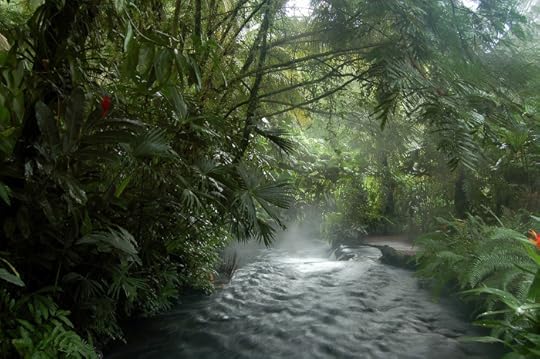
Hot Springs in La Fortuna. Photo Credit: Neil Lee
Tip: If you stay at one of the resorts outside the main area of town, it’s best to rent a car as attractions, activities, and restaurants in the Arenal area are more spread out.
Once you’ve had your fill of R&R, grab your partner for some adrenalin-pumping adventure activities. Zip-lining, hanging bridges, hiking, canyoning (waterfall rappelling), whitewater rafting, kayaking, and mountain biking are all possible out of La Fortuna. We also highly recommend spending an hour or two at La Fortuna Waterfall just outside the downtown.
For more information about visiting La Fortuna, including recommendations on where to stay, read our post La Fortuna: What to Expect from Costa Rica’s Most Popular Destination.
Days 5-7: Hit the beach. Spend a few days soaking up the sun in Guanacaste.
Once you’ve explored the verdant hills of La Fortuna, head a few hours west to the coast. Guanacaste Province has some of the most beautiful beaches in Costa Rica and show-stopping sunsets to match. You can spend these last few days of your honeymoon doing something active during the day like catching a surf lesson or snorkel tour, then as the sun sets, strolling along the sand for the start of a romantic evening.
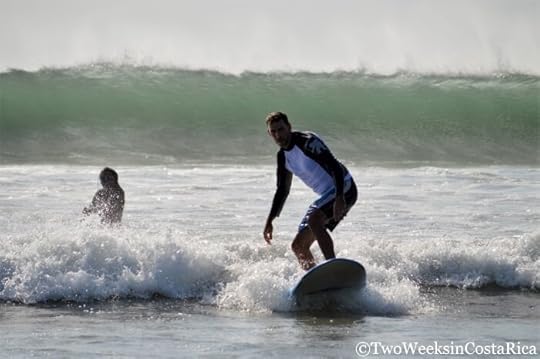
Surfing on Playa Tamarindo
There are many beach towns in Guanacaste, each with a different feel. Here are a couple of our favorites as well as some resorts for those of you looking for an all-inclusive experience.
Tamarindo
Tamarindo is the biggest town along this stretch of coast and the ideal destination for those looking for a lively beach escape. It is best known for surfing, but lots of other activities can be arranged out of Tamarindo too, like catamaran tours, wildlife boat tours of the nearby estuary, and sportfishing. The main area of town also has some decent shopping and tons of trendy bars and restaurants to choose from. For more information about visiting Tamarindo, check out our post Tamarindo: Where Paradise Meets Convenience.
Tip: If you stay near the center of town, everything is within walking distance, including the beach, so you don’t need a rental car. A rental car is nice to have, however, if you want to explore on your own outside of organized tours. Some of the biggest attractions in this area, like Llanos de Cortez Waterfall and Rincon de la Vieja National Park, are quite a distance from Tamarindo. Or you might want one to beach hop to some of the more secluded beaches like Playa Avellanas.
If you decide to rent a car, be sure to check out our rental car discount to save between 10-25%.
Playa Samara
If you’re looking for something more off-the-beaten path, there’s Playa Samara to the south. This cute seaside town is located in a more rural area of Costa Rica, in central Guanacaste Province, about four hours from La Fortuna.
Though many of the surrounding towns are small, Samara offers quite a few amenities for travelers. Along the main area adjacent to the beach, you’ll find a good selection of restaurants and casual beach bars where you can grab a drink or meal while taking in gorgeous ocean views. Popular activities in Samara include kayaking to the uninhabited Isla Chora just offshore or visiting the Werner Sauter Reserve to see wildlife like monkeys, coati, butterflies, and birds.

The beautiful Playa Samara
Resorts
For those wanting to just relax on the beach, there are several resorts in Guanacaste to choose from. Four Seasons Resort Papagayo as well as Andaz Peninsula Papagayo both offer a luxury experience complete with lofty ocean views, elaborate pools, and tastefully decorated rooms. Keep in mind that these resorts are located more remotely on the Papagayo Peninsula, to the far north, so are farther from other beach towns and attractions. To be closer to the action, we recommend the Westin Playa Conchal to the south or JW Marriott Guanacaste near Tamarindo.
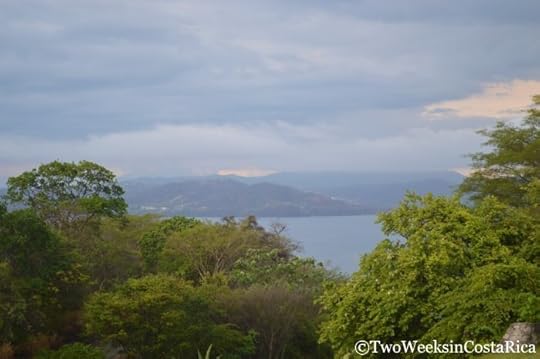
Ocean view from the Papagayo Peninsula
10 or 14 Day Costa Rica Honeymoon Itinerary
If you have more time to spend, you’ll get to see even more of Costa Rica’s romantic side. For a ten or 14 day itinerary, we recommend adding some more beach time and maybe even a stop in Monteverde after La Fortuna to see the cloud forest. Though it might not seem romantic at first blush, the misty cloud forest is mysterious and alluring in its own way, and the cooler temperatures are sure to make you want to snuggle up with your new bride or groom.
Monteverde and neighboring Santa Elena have lots of different accommodations to choose from, many of which are more rustic, ecolodge-style cabins. Some activities in Monteverde that you won’t want to miss are zip-lining in the cloud forest, hiking one of the many nature reserves, and visiting a coffee plantation. For more information about Monteverde, read our separate post Monteverde: A Forest in the Clouds.
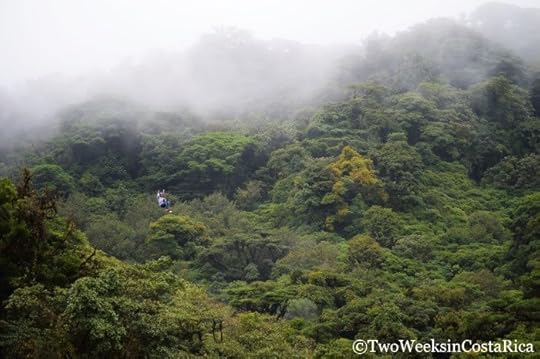
Zip lining through the cloud forest
We hope this post gives you some inspiration for an unforgettable honeymoon to Costa Rica. The experience of getting married is one of the most special moments in life and your honeymoon will be an extension of that celebration. If you ask us, there’s no better place than Costa Rica to keep the party going for a week or longer!
Have a question about planning your honeymoon to Costa Rica? Ask it below.
Want more customized help?
We can design the perfect itinerary based on your budget and unique travel interests. Prices start at just $100. Learn more by visiting our Itinerary Help page.
The post Costa Rica Honeymoon Itinerary appeared first on Two Weeks in Costa Rica.
October 27, 2015
Having a Baby in Costa Rica: Part 1
Two Weeks in Costa Rica |
With only weeks until our new addition arrives, we thought it was time to start sharing our experience of having a baby in Costa Rica. Moving here, we knew that having a baby was part of the plan. We both wanted kids, but with our old jobs in the United States, we didn’t think we’d be around as much as we’d like when the baby was born and during those early years. Moving to Costa Rica and working from home through our website has allowed us the flexibility we were looking for. Now, after traveling around the country for the first two years, we have finally settled down in one place and have a baby on the way in November! This post will share our experience so far with prenatal care and how the system works in Costa Rica. Keep an eye out for part two on delivery, which we’ll post sometime after the baby is born.

This post shares our personal experience and what we’ve learned from others. We are far from experts on this topic so opinions may differ. Hopefully, though, this is a good starting place if you’re thinking of having a baby in Costa Rica.
Background
In Costa Rica, children are held in high regard and protected to the fullest extent of the law. The law goes so far as to guarantee free health care for any child from conception to one year old. This means that all pregnant women, regardless of whether they’re Costa Rican or a foreigner, can have a baby and receive prenatal care through the public healthcare system at no cost. Public healthcare, called the Caja, usually is available only to residents and citizens who pay into the system, but pregnant women are an exception.
Public vs. Private Healthcare
We considered having our baby through the public healthcare system. After talking to other moms, both Tico and gringo, and scouring the Costa Rica expat groups on Facebook, we learned that the quality of care really varies across the country. Some of the public hospitals near San Jose are supposed to be the best and we heard that one of the hospitals in a city near us was very good too. Others, though, especially in more rural areas, don’t have a great reputation.
For us, since this is our first child and we have no idea what we’re doing, we really wanted medical staff who spoke English. We’ve heard that the way it works in the public system is you get assigned a doctor and nurse for your prenatal care and they stay with you for the entire pregnancy. You also get priority in the system and get to make appointments so that you don’t have to wait in long lines to be seen. The drawback, though, at least if you don’t speak Spanish, is that your doctor and nurse may or may not speak English (most likely they won’t). Mainly because of this, we opted for private healthcare. Although we’re working on our Spanish every day, we aren’t advanced enough to understand a lot of medical terminology. Plus, having a baby is one of those situations in life where you’re already nervous enough so having to deal with a language barrier seemed like too much.
Another consideration for us was that private health care is very affordable in Costa Rica. Even without health insurance, we could easily cover our expenses by paying out of pocket. That made the decision much easier. Once we decided on private care, we had to make the harder decision of whether to go to San Jose to one of the private hospitals like CIMA or Clinica Biblica or to stay local.
A lot of expats choose to go to CIMA, both for their monthly appointments and delivery. CIMA is a state-of-the-art hospital, similar to what you would find in North America. The equipment is modern, the doctors are supposed to be very good and many speak English, and overall, the experience is supposed to be what you’re used to if you’re from North America. We liked the idea of knowing what to expect and being comfortable, of course, but were also weighing the fact that we live almost four hours from San Jose. That had us exploring more local options, even if it was just for prenatal care.

Photo Credit: CIMA Hospital
After we found out we were pregnant and really had to figure out a game plan, we connected with an expat from the town over who had recently given birth in Costa Rica. It turned out that she had her prenatal appointments with a private, English-speaking doctor in San Isidro del General, a small city just 45 minutes from where we live near Dominical. She told us that she loved her experience with the doctor and was very happy with her care. This seemed to be the perfect solution.
Our Experience: Prenatal Care
We’ve been seeing our doctor for the last six months, the one in San Isidro who was recommended, and have had such a great experience. He always takes the time to talk with us about how I’m feeling and if we have any questions about anything. The care feels very personalized, and even though he is a busy doctor, we almost never feel rushed out like we sometimes did with our doctors in the US. He seems to be an expert in the field too. Over time, we’ve learned that he studied in Chile and is an expert in identifying birth defects and other prenatal problems through ultrasounds.
One of the things we appreciate most about our care is that I get an ultrasound (3D or 4D) at every single appointment. From talking to friends back home, it seems that ultrasounds are given much less often there and we love the little check-in it provides each month. We not only love seeing the baby, but also enjoy watching our doctor study the image on the monitor, identifying the different organs and telling us what he’s looking for.
All of this personal care is costing us only about $90 per appointment.
The facility is nice too. The doctor’s office is in a plaza right in downtown San Isidro del General. He has a waiting area just like you would expect, with a TV, some magazines, a receptionist, and air conditioning throughout. His office is adjacent to the waiting room. There is a space for his desk where we always spend some time talking, and an adjoining room with an examination bed, ultrasound machine, and other equipment.
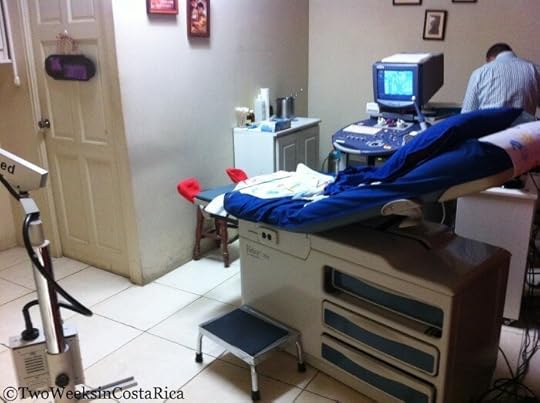
Exam room at our doctor’s office
Getting Ready for Delivery
As you might have guessed, since we love our doctor so much, it was hard to decide where to deliver. A lot of expats who opt to see a private doctor nearby choose to deliver at one of the private hospitals in San Jose. This was originally our plan too. We figured we’d see the doctor in San Isidro and then when our due date got closer, go to CIMA and find a new doctor for delivery. As we’ve mentioned, we live quite far from San Jose, so if we did this, we’d have to leave our place near Dominical in the weeks leading up to my due date and rent somewhere in San Jose waiting for the baby’s arrival.
Over the course of our appointments, we became so comfortable with our doctor that we couldn’t imagine switching mid-course. Most importantly, I was really confident in him, and we both liked his medical ideology. Unlike a lot of doctors in Costa Rica, he is pro natural delivery, water births, and even home births. Once again, our decision was easy. We would deliver at the private hospital in San Isidro and keep our doctor. Since my pregnancy isn’t high risk, we didn’t feel the need to go to San Jose.
Recently, we toured the Labrador hospital where we’ll deliver to get a sense of what to expect. It is definitely more simple (think rural US hospital) but seems more than adequate. The head nurse was very knowledgeable and walked us around to the different rooms, explaining (all in Spanish) what would happen in each place. We’ll have a private room and have heard that the place is virtually empty most of the time so you often have the whole floor to yourself. Our doctor later explained that he would be with us the entire time too, even in the early stages of labor. We left feeling really good about the whole experience and can’t wait to share how it actually goes.
Those are our thoughts on what it has been like to be pregnant in Costa Rica. One other thing we want to mention, aside from the practical info, is that the Ticos absolutely love babies. The culture adores children, and everywhere we go, strangers admire my growing belly. Many give me a smile when they pass by and others want all the details: how far along I am, if it’s a boy or a girl, and even if we have a name picked out. We felt welcome in this country before but even more so now that we’re going to have a little Tico. We can’t wait to bring him into this beautiful place.
Have a question about having a baby in Costa Rica? Ask us in the comments below.
More Posts on Having a Baby in Costa Rica. Coming Soon:
Having a Baby in Costa Rica: Part 2 – What it was like delivering a baby at a small private hospital in Costa Rica.
Where to Buy Baby Stuff in Costa Rica – Best places to buy baby gear in Costa Rica without breaking the bank.
Want to be notified when these posts come out? Click here to subscribe to our blog.
More Resources
Family Freedom Project: This website focuses on helping families achieve location independence. It has some great articles about having and raising kids in Costa Rica. Here’s a link to one mom’s story: http://familyfreedomproject.com/having-baby-costa-rica/.
Tico Times Articles: A Costa Rica online newspaper for expats, The Tico Times, recently came out with two very helpful articles about having a baby in Costa Rica. Here they are: Giving Birth Through Costa Rica’s Public Health Care System and West Side (Birth) Story: Isla arrives at CIMA.
Pura Vida for Parents: Short e-book from the Travel Mother, who lived in Costa Rica with her two young children. The book has lots of anecdotes from different moms across the country who have had a baby here or are raising a family.
Children with Families in the Central Valley – Awesome Facebook group with friendly expats living in Costa Rica with kids. This is a great place to ask specific questions about giving birth, schools, etc.
Ocho Vez – Great blog post from a Canadian woman living in Costa Rica who used the public health system for prenatal care and delivered at CIMA.
Mommy Oversees – A young expat who had her first child in Costa Rica using the public healthcare system. Her videos are honest and informative, especially the one about giving birth in a public hospital.
The post Having a Baby in Costa Rica: Part 1 appeared first on Two Weeks in Costa Rica.
October 21, 2015
Simple Spanish for Visiting Costa Rica
Two Weeks in Costa Rica |
If you are worried about not speaking Spanish for your upcoming trip to Costa Rica, you’re not alone. We remember those days too and hear from lots of others who are unsure of how they’ll get by without much or any Spanish. The good news is that many Ticos (Costa Ricans) have some English skills, and others, especially those working in the tourism industry, are quite fluent. Costa Rica is a Spanish-speaking country, however, and you are bound to get some blank stares in certain situations. In this post, we’ll give you some of the most common Spanish words and phrases for your visit to Costa Rica.

Talking with the Locals
Before we start in on the specifics, there is something you should know about talking Spanish to Ticos. Costa Ricans are in general some of the friendliest people on earth. For this reason, they will usually go out of their way to help you. This applies to speaking Spanish as well so don’t feel stupid if the person you are talking to is correcting your pronunciation or word choice. In most instances, they really appreciate that you are trying and only want to help.
Another thing that goes along with this is that many Ticos are just as shy about their English skills as you are about your Spanish. If you have the confidence to try speaking some Spanish, you might find that suddenly they get up the courage to use their English too. If you both sound bad but somehow figure it out, everyone wins!
Different Scenarios
Below are some of the situations you’re likely to encounter on your next trip to Costa Rica.
Saying Hello
Hola = Hello. This is the basic way to say hello.
Buenos días = Good morning
Buenas tardes = Good afternoon
Buenas noches = Good evening
Buenas = Shorthand way of saying hello, any time of day. It is more casual and works in the morning, afternoon, or evening. You’ll hear the locals use this all the time.
Saying Goodbye
Chao = Bye. The basic way to say goodbye.
Adiós = A slightly more formal way of saying goodbye. We have also heard adiós used as a sort of greeting and goodbye. For example, if you are driving past someone walking on the street and want to greet them, you could say adiós instead of hola. The idea is that you aren’t staying around to chat.
Hasta luego = See you later, or literally, until later.
Hasta mañana = See you tomorrow (“until tomorrow”).
Asking for Things
Discúlpe = Excuse me (when you need to get someone’s attention).
Quiero… = I would like…
Necesito… = I need…
Questions
¿Tiene…? = Do you have…? Good to use if you’re looking for a certain item at a store (e.g., ¿Tiene Tylenol?)
¿Puedo…? = Can I…?
¿Puede…? = Can you…?
¿Dónde? = Where?
¿Dónde está…? = Where is…? Useful when asking for directions or where something is (¿Dónde está el baño? Where is the bathroom?)
¿Cuanto cuesta? = How much does it cost?
¿Acepta tarjetas de crédito? = Do you accept credit cards?
¿Habla Inglés? = Do you speak English? Some Ticos might reply un poco (a little).
¿De donde eres? = Where are you from? Los Estados Unidos is the United States; Canadá is Canada. Remember that America is used to describe North, Central, and South America.
Answers
Sí = Yes
No = No
Tal vez = Maybe
Claro = Of course
In a Restaurant
Drinks
¿Para tomar? = What would you like to drink? This is usually the first thing a server will ask you.
Agua = Water. You might want una botella de agua (a bottle of water) or agua del tubo (tap water).
Una cerveza = A beer. Check out our post about the most popular local beers.
Vino = Wine. Vino tinto is red wine and vino blanco is white wine.
Café = Coffee. The server will ask you ¿Café con leche o negro? (Coffee with milk or black). Don’t worry, they always bring sugar packets.
Refresco naturale = A fruit drink with ice (hielo).
Batido = A fruit smoothie. Con agua means blended with ice and con leche means blended with ice and milk (milk shake).
Popular Local Dishes
Gallo pinto = Breakfast dish of rice and beans mixed together, served alongside eggs and fried plantain. Sometimes comes with fried local cheese (queso), toast (tostadas) or tortillas, and fruit (frutas). Gallo pinto literally translates to painted rooster.
Huevos fritos = Fried eggs
Huevos revueltos = Scrambled eggs
Casado = Lunch Plate. Casado translates to “married” and this traditional lunch dish truly has a marriage of flavors. The dish usually consists of rice (arroz) and beans (frijoles), a protein like meat (bistec/steak; chuleta de cerdo/pork chop; or pollo/chicken) or fish (pescado), and several side salads like green salad (ensalada verde), pasta salad (ensalada pasta), etc.
Arroz con pollo = Rice with chicken. This is a fried rice dish that is very flavorful. Instead of chicken (pollo), you might also see rice with shrimp (arroz con camarones) and other variations.
Sopa = Soup. Common soups are olla de carne (similar to beef stew), sopa de mariscos (seafood soup), and sopa negra (black bean soup, usually with a poached egg). Soups are typically served with a side of white rice.
Cashing Out
Para llevar = To go (for your leftovers)
La cuenta, por favor = The bill, please. In Costa Rica, the server won’t bring this unless you ask for it.
Servicio = Service. This is the 10% added to the bill for tip. You can add more if you like.
Impuestos ventas = Sales tax (13%)
Transportation
Estación de buses = Bus station
Parada de bus = Bus stop
Tiquete = Ticket (for the bus, ferry, etc). Not all buses use tickets but it is good to ask. ¿Necesito un tiquete? (Do I need a ticket?).
Taxi = Taxi
¿A donde va? = Where are you going? What’s your destination?
Voy a… = I am going to…
Pare aquí = Stop here
¿Esta es la calle a…? = Is this the road to…?
Lleno con regular, por favor = Fill it with regular (gas) please. Gas stations in Costa Rica are always full service.
La llanta necesita aire = The tire needs air.
We hope these simple Spanish words and phrases will help you feel more comfortable while traveling to Costa Rica. When we first visited almost ten years ago, we had zero knowledge of Spanish and got along fine. Just remember, the one term you need to learn is Pura Vida. This can mean hello, goodbye, and that’s great, but the real meaning is more of an attitude that you will discover once you arrive and will never forget.
If you’re looking for a lot more helpful words and phrases, we highly recommend the pocket-sized Costa Rican Spanish Phrasebook by Lonely Planet. This is what we used to carry with us when we were newbies and it got us out of a lot of jams.
Notice anything essential missing from our list? Add it to the comments below!
Looking for more resources for your upcoming trip? Check out these posts:
Costa Rica Wildlife Guides: Our Picks – One of the biggest draws of Costa Rica is the magnificent wildlife. Be prepared with these books in your backpack.
Driving in Costa Rica: What to Know Before You Go – Hit the road with confidence. This post shares some essential safety tips and lots of general info about what it’s like to drive in Costa Rica.
Packing for Costa Rica: The Essentials – It’s one thing to forget your toothbrush but have you thought about the must haves you’ll need for here in the tropics? This post will get you started.
Money Matters: Currency, Exchanging Money, and Tipping in Costa Rica – Everything you need to know about Costa Rica’s currency, including the best ways to exchange money once you get here.
The post Simple Spanish for Visiting Costa Rica appeared first on Two Weeks in Costa Rica.
October 14, 2015
7 Things to Do in Dominical
Two Weeks in Costa Rica |
Dominical is probably best known for its waves, which draw surfers from all around the world. But there’s a lot more to this quirky beach town and the surrounding stretch of coastline called the Costa Ballena than just surf. What we love most about this region of Costa Rica is the combination of jungle-filled mountains and ocean. The nearby hills are a playground for wildlife and hiking enthusiasts, and the nearly deserted beaches are the perfect escape for those looking to relax and unwind. In this post, we share seven of our favorite things to do in Dominical.

Things to Do in Dominical
Nauyaca Waterfalls
One of our favorite things to do in Dominical (and in Costa Rica for that matter) is hiking to the Nauyaca Waterfalls. Whenever we have friends or family in town, we always take them there and it ends up being one of their favorite activities too.
This two-tiered waterfall is one of Costa Rica’s most dramatic, with a 61 meter (200 foot) combined drop and a deep natural pool for swimming. You can arrive to the falls on horseback, or if you’re up for a moderately difficult hike, we recommend arriving on foot so that you can take in the gorgeous surrounding rainforest. For more information about the hike, check out our post, Visiting the Beautiful Nauyaca Waterfalls.

Hacienda Baru Wildlife Refuge
One of the best places in the area for a day hike is Hacienda Baru. Hacienda Baru is a hotel and wildlife refuge off the highway just north of Dominical. What makes this property so special is the diversity of habitats, which include primary and secondary forest, mangrove, grassland, and even beach. Monkeys, sloths, peccaries (similar to a wild boar), white-nosed coati, and caimen are often seen along the trails. And if you’re into birding, Hacienda Baru is one of the best places around with over 330 species identified!
The 4.3 miles (7 km) of trails at Hacienda Baru are well maintained so self-guided hikes are an option, but you may see more wildlife with the help of one of the reserve’s expert guides. For more information about visiting, including detailed info on the different trails, see our separate post.

Parque Reptilandia
Reptile enthusiasts or just anyone with an appreciation for nature will love Parque Reptilandia. This outdoor park has tons of different enclosures where you’ll see reptiles from Costa Rica and all around the world. Snakes make up the majority of exhibits, but they also have other interesting creatures like tortoises, crocodiles, and lizards. One enclosure also has several poison dart frogs, so if you’ve been wanting to see these adorable amphibians, Reptilandia is the place to go.
This is a fun spot to visit for a couple of hours and a great activity for kids. $12 for adults, $6 for children 14 and under.
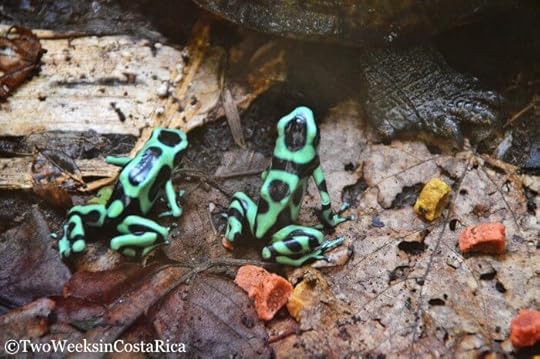
Green and Black Poison Dart Frogs
Alturas Wildlife Sanctuary
If you want to get up close to some of Costa Rica’s most exotic wildlife, you’ll want to check out the Alturas Wildlife Sanctuary. This center does some extremely important work for area wildlife. They rescue and rehabilitate animals and birds that have been injured or abandoned in the wild or confiscated in the illegal pet trade, then nurse them back to health in the hopes of release. The wildlife you’ll see is constantly changing, but the center often has white-faced capuchin monkeys, howler monkeys, white-nosed coati, sloths, armadillos, kinkajoos, and anteaters.
Minimum donation $25 for adults, $15 for children 12 and under.

White-faced Capuchin Monkey
Whale Watching
The Costa Ballena (Whale Coast) gets its name from the hundreds of humpback whales that migrate to the region’s warm waters every year to breed and rear young. This is one of the most special areas in the world for whale watching so if you’re visiting Costa Rica during whale season, it is something you won’t want to miss. The best time of year to see humpbacks and their babies is from July to April, with peak times in the Costa Ballena during September and October. Whale watching tours can be arranged in Dominical and also the adjacent town of Uvita.
For more information about whale watching in Costa Rica, read our separate post.

Kayak/SUP Mangrove Tour
If you’re looking for a more low key activity, take a kayak or stand-up paddleboard (SUP) tour through the mangroves. As you creep along the calm water, you’ll learn about the ecology of this important ecosystem and get to see some of its inhabitants, like herons, kingfisher, crabs, raccoons, and maybe even crocodiles, monkeys, and sloths. If you’re looking for a little more excitement, ocean trips by kayak or SUP are another option.
Tours can be arranged in Dominical and cost around $65 per person.

Souvenir Shopping
If you have some time after one of your excursions, be sure to peruse the souvenir stands right along the beach in Dominical. Every day, locals sets up shop in between the palm trees, selling everything from T-shirts, sarongs, and towels to jewelry, handmade wooden items, and even hammocks. Once you’ve had your fill of shopping, grab a beer and watch sunset at one of the casual bars right on the strip.

Need More Ideas?
Those are our top seven things to do in Dominical. If you’re looking for more ideas, there’s also the popular beach town of Manuel Antonio about 45 minutes north. Manuel Antonio offers even more activities like whitewater rafting, parasailing, hanging bridges, a spice farm tour, and lots more.
Have you visited Dominical? What was your favorite activity?
Looking for more info to help plan your trip? Check out these posts:
Drake Bay: Costa Rica Unplugged – If you’re heading south after Dominical to the Osa Peninsula, make sure to read our destination guide all about Drake Bay.
San Gerardo de Dota: A Hideaway in the Cloud Forest – Want to cool off after the beach? This tiny mountain town is a great place to experience the cloud forest and is only a couple of hours from Dominical.
How to Spend 1 or 2 Days in San Jose, Costa Rica – Dedicating a day or two to exploring the city is a great idea. Check out our recommendations for museums, restaurants, and hotels.
The post 7 Things to Do in Dominical appeared first on Two Weeks in Costa Rica.
October 7, 2015
The Painted Oxcarts of Sarchi
Two Weeks in Costa Rica |
Long before eco-tourism vans took to the roads of Costa Rica, there was another much simpler mode of transportation: the oxcart. Brightly painted with intricate designs, these original wagons or their replicas can be seen throughout the country in restaurants, businesses, and on the shelves of souvenir shops. This icon of Costa Rica was once used by farmers to transport goods like sugarcane and coffee beans. Today, in the town of Sarchi, they are still made in the traditional style. In this post, we’ll let you know how you can visit this charming town and see these beautiful carts for yourself.

Sarchi and Its History
Just 30 minutes northwest of the international airport near San Jose (SJO) is Costa Rica’s capital of oxcart production, Sarchi. You’ll know you have arrived thanks to the giant oxcart replica (the biggest in the world) right in the town’s central park.

This huge oxcart sits in Sarchi’s Central Park.
For over 100 years, farms near Sarchi have been producing some of the country’s best coffee beans. Needing a sturdy way to transport this precious cargo to ports on the coast, a demand for ox-drawn carts was born. The earliest oxcarts of Sarchi dating back to the late 1800s were simple and functional. But as time went on, craftsmen began incorporating their own unique markings to distinguish their carts. By the beginning of the 20th century, competition among artisans was strong, and carts were decorated with elaborate geometric patterns, similar to the designs that can be seen today.
In addition to Sarchi, oxcart makers in other towns around Costa Rica decorated their carts in a slightly different way. At one time, it was said that you could tell which specific towns were represented at a shipping port just by comparing the carts.
Visiting an Oxcart Manufacturer
Today there are two factories in Sarchi that you can visit to see how oxcarts were traditionally made and painted. Both Fabrica de Carretas Joaquin Chaverri and Fabrica de Carretas Eloy Alfaro offer daily demonstrations where you can get a closer look. We recently visited Fabrica de Carretas Eloy Alfaro and will give you an overview of what we saw.

Oxcart Fabrication
At Fabrica de Carretas Eloy Alfaro, you can still find much of the original equipment that was used to make thousands of oxcarts over the years. If you are a woodworker, this is your place. The small outdoor factory is positioned on a stream and uses a waterwheel to power much of the machinery. Although the equipment is dated, over the years there have been some upgrades. For example, in 1934, the large wheel was converted from wood to metal. It was upgraded again in 1965 to a stronger iron.
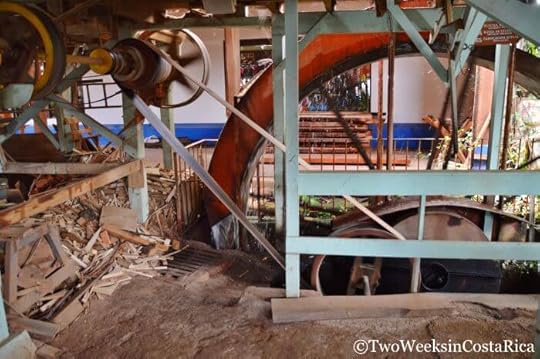
The original waterwheel with its belts spinning.
The most prominent part of any oxcart is the wheels. They are also the feature that is the most complex to build. Square and rigid pieces of wood like Spanish cedar, mahogany, and laurel are first stacked to dry. Then when they are ready, each piece is carefully cut into the shape of a wedge. Sixteen different wedges make up each circle and they are bound together with a heated metal ring to make a wheel. The wheels are then sanded smooth. While watching the process, you’ll notice some large clunky belts spinning overhead, which connect the machinery to the waterwheel. These belts are what power the table saw, sander, and any other tools needed by the craftsmen. Once the wheels are complete, they are passed on to the artists who paint them.
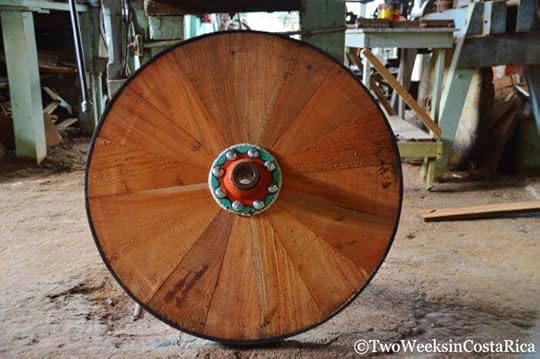
A finished wheel ready for painting.
Painting an oxcart wheel isn’t as simple as it sounds, especially when the designs are so intricate. But just across from the woodshop at Eloy Alfaro are several painters who are continuing this tradition. These talented individuals paint each detail by hand with narrow brushes. In addition to the wheels, they decorate all the other parts of the oxcart as well.
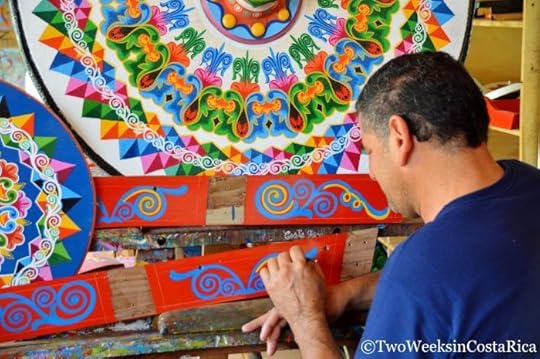
An artist hard at work.
Other Artwork and Gift Shop
Walking around Fabrica de Carretas Eloy Alfaro, you’ll see that the artists have painted just about every other surface in the place too. One of our favorites is a replica of the Alegoría al Café y al Banano (Allegory of Coffee and Bananas) that is painted on a wall. The original of this mural can be found on the ceiling of the National Theater in San Jose. It depicts the Port of Limon on the Caribbean Coast with bananas and coffee being exported.
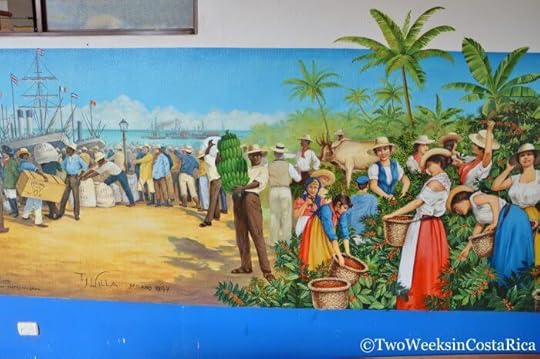
The famous mural “Allegory of Coffee and Bananas” replica.
After the demonstrations, you can also check out the huge gift shop for a keepsake. The shop has all the usual souvenirs like oxcart replicas, T-shirts, key chains, wooden bowls, and indigenous masks, but most interesting to us are the rocking chairs.
In addition to its oxcarts, Sarchi is also known for its furniture. All around town, you’ll find stores displaying beautiful wooden pieces from beds and bookcases to chests and dining sets and traditional rocking chairs. These chairs are made of native wood, have a leather seat and back that are often decorated in a traditional Costa Rican theme, and fold up nicely for transport/shipping. We actually picked one up ourselves in anticipation of our baby arriving this November!
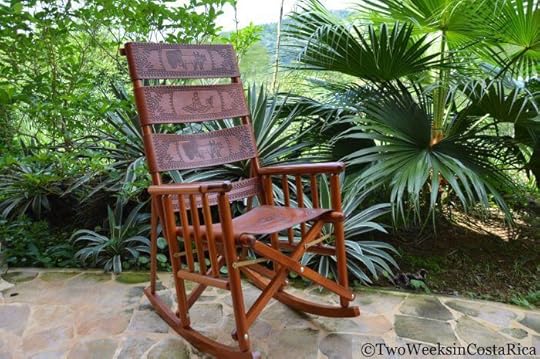
A typical Costa Rican rocking chair
Location
Here is a map with both Fabrica de Carretas Eloy Alfaro and Fabrica de Carretas Joaquin Chaverri.
Hours
Fabrica de Carretas Eloy Alfaro – Open daily, 7:00 a.m. to 5:00 p.m.
Fabrica de Carretas Joaquin Chaverri – Open daily, 8:00 a.m. to 5:00 p.m.
We hope that you get a chance to visit the town of Sarchi to see these beautiful carts for yourself. If you have a free afternoon near the airport or are visiting the Poas Volcano area, Sarchi isn’t far away and is a great activity to add to your itinerary.
Have you visited Sarchi? Tell us what you thought in the comments below.
Looking for more info on this area of Costa Rica? Check out these posts:
Los Chorros Waterfalls: Grecia’s Natural Jets – These spectacular waterfalls are just a few towns away from Sarchi and are really easy to access.
How to Spend 1 or 2 Days in San Jose – If you want to explore Costa Rica’s rich history, be sure to make time for the museums in downtown San Jose. Here’s our guide for activities, restaurants, and hotels.
Best Hotels Near SJO Airport – Staying near the airport doesn’t mean you can’t enjoy yourself. See our picks for comfy places to stay that you might never want to leave.
The post The Painted Oxcarts of Sarchi appeared first on Two Weeks in Costa Rica.
September 30, 2015
Money Matters: Currency, Exchanging Money, and Tipping in Costa Rica
Two Weeks in Costa Rica |
If you’re a first time visitor to Costa Rica, you probably have some questions related to money. Maybe you’re wondering about the best way to exchange currency or want to be sure you can use your credit card during your travels. Or perhaps you want to know if it is customary to tip in Costa Rica. In this post, we’ll answer these questions and more to get you ready for your trip.

Currency and Exchange Rate
Costa Rica’s currency is the colon (₡), named after Christopher Columbus. It comes in both paper and coin form. The paper money goes from bills of ₡1,000 (called a “mil” (Spanish for 1,000) or “un rojo” because of the bill’s red color) to ₡50,000, but we’ve never seen anything higher than ₡20,000 come out of the ATM. Coins go from an almost valueless ₡5 to ₡500 (“quinientos” (Spanish for 500)) and are quite heavy for the higher denominations.
Be sure to get a good look at the paper money while you’re here because it is gorgeous. Each depicts a different colorful scene from Costa Rica, from the ₡1,000 bill with the tropical dry forest, iconic Guanacaste tree, and a white-tailed deer, to the ₡10,000 bill depicting the rainforest, a sloth, orchids, and birds.

Costa Rica’s beautiful paper money. Photo Credit: Central Bank
The exchange rate fluctuates daily but usually works out to between ₡500-550 per US dollar. To give you an example, if something costs ₡1,250, it is a little less than $2.50. An easy way to think of it is to double the amount in colones and move the decimal point. Here are the most common bills and their estimated USD equivalent using this method:
₡1,000 is about $2.00
₡2,000 is about $4.00
₡5,000 is about $10.00
₡10,000 is about $20.00
₡20,000 is about $40.00
*Note that the higher the bill, the more off it will be if you use the doubling calculation. For example, if the current exchange rate is ₡550 for each dollar, a ₡20,000 bill will equal only about $36 instead of $40.
Exchanging Money
In addition to colones, US dollars are widely accepted throughout the country, though it is best to have some local currency to use as well. There are a few different ways to deal with changing money in Costa Rica. What we used to do when we traveled as tourists was bring some US dollars ($20s or less as bigger bills are not widely accepted) and use them to get local currency back as change. Then when we ran out of money, we would get colones out of the ATM with our debit card. This saves the hassle of having to exchange money and also the fees involved with that.
If you go this route, be sure to use the US dollars at larger grocery stores, restaurants, etc. where they’re doing the transaction through a computer so that you get the correct exchange rate. Cab drivers, buses, and other smaller places are not likely to do the math based on the actual exchange rate and usually will base the transaction on an unfavorable (to you) rate of ₡500 per USD. For this reason, use local currency for these types of smaller transactions.
Another option is to exchange money when you arrive in Costa Rica. This is best done at a local bank because they will give you the most favorable exchange rate. Be sure to bring your passport and some patience, as the lines at banks can be long. Although it is also possible to change money at the airport, they have the worst exchange rates so are best avoided.
As we mentioned above, you also can get local currency out of the ATM as long as you’ve authorized your card for use internationally. Keep in mind that usually only debit cards and not ATM cards work. ATM machines can be found throughout Costa Rica and in most tourist destinations. A couple of noteworthy exceptions are Drake Bay on the Osa Peninsula and Tortuguero on the Caribbean Coast.
Tip: Use Banco de Costa Rica (BCR) for ATM withdrawals if you can. This bank doesn’t charge a fee for use of its machine so you’ll only have to pay whatever your home bank charges for using an out-of-network machine. If you have a US bank, you may also get charged a foreign currency conversion fee for taking out local currency so be sure to inquire. Last time we checked, this fee was 3% of the total amount withdrawn for our bank back in the States, though the percentage can vary.
Using Credit Cards
One very convenient aspect of traveling in Costa Rica is that credit cards are widely accepted. We prefer to use our card whenever possible because we know we’re getting the correct conversion and it’s nice not to have to carry a lot of cash around. Many restaurants, hotels, gas stations, and tour operators accept credit so be sure to ask. The Spanish phrase is ¿Aceptan tarjetas de credito? Mastercard and Visa are the most widely accepted.
Tip: Be sure to ask your bank about its fees for foreign transactions so that you don’t have any surprises when you get back home. These charges typically range from 1-3% of the total transaction amount. Credit unions tend to have the lowest fees. If you travel out of the country frequently, you could also consider getting a travel credit card, which doesn’t have fees for international purchases. We’ve had good luck with our Capital One and Bank of America Travel Rewards Cards.
Traveler’s Checks
Traveler’s checks are not widely accepted in Costa Rica so we don’t recommend them.
Tipping
Tipping is less customary in Costa Rica than in some other countries like the United States. Many people don’t tip at all, but because wages are fairly low in Costa Rica and don’t match the higher cost of living, we often tip. Here are some different scenarios for how to handle tipping.
Restaurants
At restaurants, 10% gratuity is always included in the bill. Sometimes it is a separate line item called servicio (service) that you can see right on the bill. Other times, the 10% is included in menu prices (sometimes the menu will say this but not always). Although it can be hard to tell if service is not listed separately, know that it is included somewhere and you are indeed being charged.
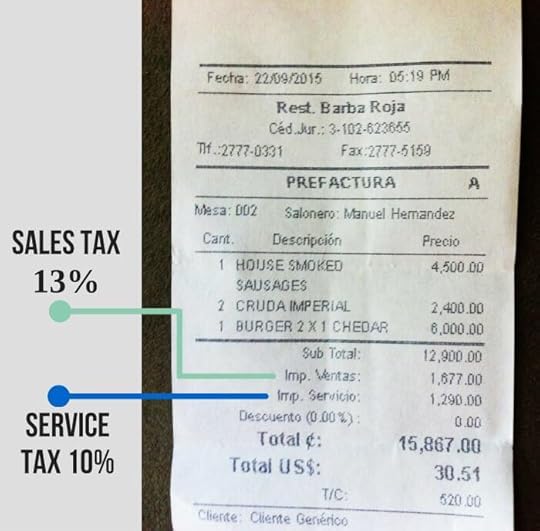
Typical bill at a restaurant. Note the separate line items for tax and service.
As for leaving more than the 10%, the locals usually don’t and servers don’t expect it, but we like to leave a little extra for exemplary service or if the bill is very low. At sodas (traditional Costa Rican restaurants), the bill is often less than $10 a person so we leave an extra ₡500 or ₡1,000.
Tip: Some people complain of slow service (and tip accordingly) because it took so long to get the check. Keep in mind that servers will usually not bring the bill unless you ask for it because they think it is rude to kick you out. Just ask and they will be happy to bring it.
Taxis
Cab fares are regulated in the San Jose area, but elsewhere in the country, you might have to negotiate the fare with the driver. When there is a meter, we usually leave a little extra beyond the meter price. And when there isn’t a meter, we try to judge if the price we were given was in line with the going rate. If it seems fair, we’ll leave a dollar or two extra, and if it seems inflated (which sometimes happens in tourist towns), we’ll just pay what we agreed to.
Bell Boys/Bag Handlers and Housekeeping
$1-2 per bag for a hotel bell boy or shuttle van driver who helps with your luggage is customary. For housekeeping, we like to leave $1-2 per day.
Tour Guides
For someone who is taking you on a guided tour like to a national park/reserve, it is nice to leave a tip since they’re sharing their knowledge and expertise with you. Ten to 15% is a standard range.
Additional Advice
If you don’t have a good grasp of Spanish, many merchants will sense that you are confused and show you the total price in colones on the register’s screen or on a calculator. Almost all small grocery stores have a calculator handy.
We keep an emergency backup of cash on us just in case we end up somewhere that doesn’t accept credit or our card won’t swipe, or worse, we lose our wallet. Matt’s money belt (see here) has saved us on multiple occasions.
If you’re traveling during holidays, keep in mind that ATMs near popular tourist towns may run out of money and not be restocked right away. Lines at banks around holidays also can be very long so plan accordingly.
Those are our tips for how to handle money matters on your next trip to Costa Rica. If you have a question about something that we didn’t address, feel free to ask us in the comments below.
Looking for more information to plan your trip? Check out these posts:
Cost of Traveling in Costa Rica: Now that you know how to handle money, use this post to figure out how much you’ll need. Detailed breakdown of what to expect for lodging, tours, transportation, and restaurants.
Driving in Costa Rica: Tips for navigating Costa Rica’s crazy roads. Conditions, rainy season travel, local customs, what to do if you get in an accident, and more.
Rental Car Discount: Find out how to save 10-25% on a rental car in Costa Rica with our exclusive discount.
The post Money Matters: Currency, Exchanging Money, and Tipping in Costa Rica appeared first on Two Weeks in Costa Rica.
September 23, 2015
Getting Your Home Ready for a House Sit: 12 Tips for Homeowners
Two Weeks in Costa Rica |
We’ve been house sitting in Costa Rica for a couple of years now and have walked into all different kinds of situations. Sometimes homes and pets are prepped and ready for a seamless handover, while other times, things are hectic and chaotic. In this post, we offer some tips from our perspective as house sitters on things homeowners can do to get their house ready for a house sit.
Discount Code: Check out the bottom of this post for a code to save 10% on a Trusted Housesitters Membership.

1. Make Space for the House Sitter
This is probably the most overlooked item on this list, but it’s important. You are, after all, trusting this person to take care of your home and precious pets while you’re away. With so much responsibility being handed off, you want to get off to a good start. The perfect way to do that is to make sure the house sitter feels welcome and comfortable.
Simple things will go a long way. Have clean sheets on the beds and towels in the bathroom. Set aside space for them throughout the home. Make room in the closets so they have a place for their clothes, and in the cabinets and refrigerator. It is also a good idea to clean out the fridge as much as possible. We’ve had some house sits where the refrigerator and freezer have been almost completely full, leaving us no space for our own groceries. When this has happened, it is usually full of nearly empty beverage containers, salad dressings, and condiments. This can be frustrating since it forces the house sitter to sift through the items and decide whether to toss things to make room. Taking a little time to clean out your fridge and pantry prior to the house sitter’s arrival will be much appreciated.
2. Define Off-Limit Areas
If there are items or rooms that are off-limits, that is fine, just be sure to put things away and let the house sitter know.
3. Emergency Contacts
If you haven’t already done so, give the house sitter a list of people in the area to contact in case of emergency. Also give them the name of a friend or trusted neighbor in case they have a question about the house or your pets and can’t reach you right away. Also be sure to provide the name and contact info for the local vet and whether they do emergency visits during non-business hours.
It is a good idea to put this and other important information in one document for the house sitter so that they can refer to it during the house sit. They will likely not remember the fine details of everything that you tell them on the day of the handover so it helps to have it in writing. Leaving a printed version somewhere in the house is also good in case the power or Internet goes out and the house sitter can’t access the document online.
4. Details on Nearest Medical Facilities
Since the house sitter is unlikely to be acquainted with the area, it will help to provide them with info on the nearest hospital in case of an emergency. A recommendation for your favorite local dentist would also be good just in case.
5. Your Contact Info
Be sure to leave your travel itinerary with the house sitter and best way to reach you on every leg of the trip. We’ve been in the unfortunate position of not being able to reach a homeowner when we had a major issue with the house because they took a mini-vacation and forgot to tell us. We’ve also had to get in touch with homeowners when an urgent piece of mail arrived at the house.
6. Utilities
Make sure that the house sitter has your account information for electricity, gas, water, internet, security system, etc. in case of an outage or other problem. Also be sure to walk them through where the major systems are located and how they work. We have had to deal with several water problems in Costa Rica during house sits and it was nice to know how the pipes were run and system functioned. If you have the owners’ manuals for appliances and utility systems in one spot, that’s even better.
7. Gardeners, Housekeepers, and Other Hired Help
If anyone comes on the property to perform services, explain exactly who comes, when they come, and what their job duties entail.
8. Money for Hired Help, Bills, etc.
If the house sitter is responsible for paying hired help or bills on your behalf, be sure to leave them enough money. Most house sitters prefer to have the money upfront rather than being reimbursed later on. If it is a large sum, you could always arrange to have additional funds be sent to them midway through the house sit. Most house sitters will do an accounting of how the money is being spent, but it doesn’t hurt to ask specifically for this upfront.
9. Pets
If your house sitter will be taking care of your pets, make sure you have adequately stocked up on supplies (food, medication, etc.) or are leaving money for the house sitter to replenish them. Also be sure to provide instructions on when any medications should be administered and notify them if there are any behavioral issues that they should be aware of (e.g., barking, biting, behavior around other dogs, frightened by thunderstorms, etc.).
10. Trash and Recycling
Don’t forget to tell the house sitter trash pick-up days and what to do with recycling.
11. Spare Keys
Leave a spare set of keys with a neighbor or friend and be sure to let the house sitter know how to get in touch with them.
12. Welcome Meal
It is always much appreciated if you have a meal prepared for the house sitter’s first night in the house. This is especially true if the house sitter has traveled a great distance. The meal doesn’t have to be anything special; it’s more of the thought that counts. You can bet that if you leave a lasagna or casserole in the fridge for the house sitter’s first night, they’ll pay it forward and have something yummy for you when you return.
We hope that this checklist helps get you ready for your first house sitters. It may seem like a daunting list, but it is far easier to address these issues upfront than to wait for a problem to arise and have to deal with it from the road.
Have something to add? Let us know in the comments below.
Trusted Housesitters Discount Code
We are very excited to have teamed up with Trusted Housesitters, one of the most highly regarded house sitting websites, to get our readers a special discount on memberships.
To save 10% on your homeowners or house sitters membership, just visit Trusted Housesitters using the following link http://www.twoweeksincostarica.com/trusted-housesitters and enter the code COSTARICA at check-out. You’ll save 10% on any membership plan you choose, including renewals!
If you purchase a membership using the link above, we receive a small commission at no extra cost to you.
The post Getting Your Home Ready for a House Sit: 12 Tips for Homeowners appeared first on Two Weeks in Costa Rica.
September 16, 2015
Best Hotels Near SJO Airport
Two Weeks in Costa Rica |
With crazy flight schedules and lengthy drive times between most destinations and the airport, sometimes an overnight near Costa Rica’s SJO (Juan Santamaria International) airport is inevitable. But just because you are close to the San Jose airport doesn’t mean these nights can’t be part of your vacation too. In fact, only a few minutes from the runway are a plethora of charming B&Bs and hotels that will give you a taste of Costa Rica’s welcoming culture and beautiful scenery.

Hotels Near SJO Airport
Below you will find our picks for the best hotels near SJO airport. They are all within a 20 minute drive of SJO so make for a stress-free pit stop when arriving in or leaving Costa Rica. We’ve stayed in each of the hotels ourselves or toured them with an eye towards our reader’s needs (i.e., quiet neighborhood, comfy beds, good food, etc.). Each offers something a little different and we hope we’ve included something that is right for you.
Hotel Buena Vista
Hotel Buena Vista may be only 7 km from Alajuela but couldn’t feel farther removed from the hustle and bustle of the city. Set in the mountains among lush forest, this hotel has gorgeous views of the surrounding valley. Rooms are spacious and tastefully decorated, many with private balconies to take advantage of the views. Standard rooms are good for couples, while the larger suites and villas are an excellent choice for families. $125-200, includes free airport shuttle and breakfast. Check Rates and Availability Here.

View from Hotel Buena Vista
Hotel Terrazas de Golf
We loved our stay at Hotel Terrazas de Golf. Overlooking the golf course in Cariari, this boutique hotel offers spacious, comfortable rooms for a great price. Owner Cecilia and her son are super friendly and helpful if you need a recommendation or help during your stay. This hotel is also a great option for golf lovers, as a course is right next door. $80-150, includes free airport shuttle and a delicious breakfast. Check Rates and Availability Here.

Terrazas de Golf
Hotel Alameda Cariari
Just down the street from Terrazas de Golf is another excellent value option. Hotel Alameda Cariari offers 10 unique rooms in an opulent, mansion-like building. We were skeptical of the gleaming photos online, but found that the rooms really are that nice in person. $50-100, includes breakfast. Check Rates and Availability Here.

Foyer of Alameda Cariari
Hotel La Rosa de America
Hotel La Rosa de America is a small family-owned hotel just north of the airport with a lot of local character. Though conveniently located right off a main road, the hotel is set back so nice and quiet. Nicely landscaped grounds and a pool make it feel like you’re not in the city. La Rosa has a few different types of rooms available for all budgets. The quadruple rooms and family suites with bunk beds are perfect for groups and families. $60-130, includes breakfast. Check Rates and Availability Here.

Grounds of Hotel La Rosa de America
Hotel Los Volcanes
For those wanting to check out the local culture, there’s Hotel Los Volcanes. We’ve stayed here several times and even wrote about it in our travelogue, Two Weeks in Costa Rica. This B&B-style hotel in a converted mansion is located in downtown Alajuela. Not far from the hotel is a vibrant central park and cathedral, market, and many restaurants where you can see the comings and goings of the locals. Opt for a superior double room for the most space and amenities. $50-75, includes breakfast and airport shuttle. Check Rates and Availability Here.

Photo Credit: Hotel Los Volcanes
Adventure Inn
This mid-size hotel is a favorite among frequent travelers to Costa Rica. Known for its convenience and comfort, Adventure Inn offers a shuttle schedule, free phone calls to the US, good Wifi, and a choice of American or Tico-style breakfast. Rooms range from standard with two queen beds to more spacious triples that are good for families. $80-120. Check Rates and Availability Here.

Adventure Inn
Villas San Ignacio
Villas San Ignacio is a boutique hotel with an old-world feel. Good for couples, the rooms are simply decorated yet well appointed. The hotel has a spacious pool area and on-site restaurant serving up delicious, gourmet offerings. Villas San Ignacio is also a good jumping off point for visiting the nearby Poas Volcano or going on a coffee tour. $85, includes breakfast. Check Rates and Availability Here.

Villas San Ignacio
Still Looking for a Hotel near San Jose?
Because many of these hotels are smaller, they tend to book up quickly during peak travel times. If you need some more ideas, there’s the larger Courtyard Marriott ($100-200) in Alajuela with clean, spacious rooms you would expect from the Marriott chain. Another solid budget option that we’ve enjoyed is Hotel Aeropuerto ($75-100). Hotel Aeropuerto is about as close to the airport as you can get and offers a 24-hour airport shuttle, perfect for if you’re getting in late.
Some of the links in this post are affiliate links. If you book a hotel using one of the links, we receive a small commission at no extra cost to you. By booking with the links, you help us keep our blog going, so thank you! Read our Privacy Policy for more information.
Have a favorite hotel near SJO that we didn’t mention? Leave a comment below and share your experience.
Looking for more basics to plan your trip? Check out these posts:
Packing for Costa Rica: The Essentials – Detailed list of just what to bring.
Costa Rica Rental Car Discount – Information on how to save up to 25% off a rental car.
Weather in Costa Rica – A must-read if you’re traveling during the rainy season.
The post Best Hotels Near SJO Airport appeared first on Two Weeks in Costa Rica.
September 9, 2015
Whale Watching in Costa Rica
Two Weeks in Costa Rica |
Costa Rica is probably best known for its wildlife on land. Monkeys, sloths, birds, and butterflies often steal the show and for good reason. But what some forget is that the waters right offshore are full of life too. Sea turtles, tropical fish, dolphins, and whales all frequent the waters of Costa Rica’s two coasts. In this post, we’ll focus on whales, specifically humpback whales, and let you know when and where you can spot these gigantic, mystical mammals.

Whale Migration
Costa Rica is a prime whale watching destination and it is all thanks to the spectacular annual migration of two groups of humpback whales. This long journey starts when temperatures in both North and South America start to cool during their respective winters. Humpbacks quickly head toward the equator where waters are warmer—and Costa Rica is one of their favorite spots. An amazing fact is that this migration is the longest of any mammal in the world, spanning a distance of up to 5,160 miles (8,300 km). These whales can go fast too, and one was recently recorded by NOAA making a 3,000 mile (4,830 km) trip in only 36 days!
Once the whales get to Costa Rica, it’s not just about vacationing in the sun. Humpbacks congregate together and use the months that they are here to find suitable mates, breed, and rear young. The temperate waters are thought to be ideal for the growth of baby whales, even though they can already be 13-16 feet (4-5 m) long and weigh up to 1 ton (907 kg) at birth.

Mother and calf surfacing together
When You Can See Whales in Costa Rica
As we mentioned, there are two different migrations for humpback whales: one from areas to the north like Alaska and California and another from the Antarctic zone to the south. These migrations happen at different times of year but don’t overlap. Northern humpbacks start to arrive in Costa Rica in December and stay until around April, while southern ones don’t show up until later in July and stay until the beginning of November. This means that Costa Rica has humpback whales for nine months out of the year.

Fast Facts
The Antarctic migration has the most whales and peak season is between August and October.
Some of the Alaska/California whales winter in Hawaii so their numbers are fewer in Costa Rica.
There typically aren’t any humpbacks to see from mid-April to mid-July.
Humpbacks in the northern Atlantic Ocean also migrate near Costa Rica (on the Caribbean Coast) but are not found in great numbers so whale watching isn’t as popular as on the Pacific.
Where to See Humpback Whales in Costa Rica
Although it is possible to see humpback whales along many parts of Costa Rica’s Pacific Coast, they tend to congregate in the Southern Pacific. The Osa Peninsula and Gulf of Dulce have high numbers of whales as well as the beach towns of Uvita and Dominical on the Costa Ballena (Whale Coast). Uvita is probably the town best known for whale watching. In Bahia Uvita, boats launch right from the beaches of Marino Ballena National Park, the National Whale Marine Park. This is a protected area of both land and ocean, which is known for attracting whales close to shore.

Whale watching tours out of Uvita are done on smaller boats, holding about 15-25 passengers, and cost around $70-85. The focus of these tours is on whales, but you’re likely to spot pods of dolphins, sea turtles, rays, and other marine life while out on the water as well. These tours also typically include some time for snorkeling.
While tours devoted to whale watching are most common in the Southern Zone, if you’re visiting areas in northern Costa Rica, like Guanacaste, you might still be able to witness these giants passing through. Humpbacks or other types of whales are sometimes spotted on catamaran, snorkel, or dive tours.

More Facts
Humpbacks make spectacular displays with their fins and tails and are known to jump out of the water on occasion. Have your camera ready!
Males compete for females by singing songs, making elaborate bubble displays, and physically fending off one another.
A baby arrives about 11 months after mating and calves stay by their mother’s side for up to a year. They can often be seen touching fins to show affection.
Annual Whale and Dolphin Festival
One of the best times to take a whale watching tour is during the Annual Whale and Dolphin Festival in Uvita. This festival occurs every year during peak season, typically in early September, so your chances of spotting whales is almost guaranteed. Abbreviated two hour whale and dolphin watching tours are given by local tour operators during the festival and there are other events like dancing and music, a beach run, mountain bike race, and lots of activities for kids too. We attended last year and saw several whales, including a mother and calf as well as some dolphins and a sea turtle. With the beautiful green coastline, the view from the boat alone was worth the price for admission (around $40/pp).

Have you been whale watching in Costa Rica? Leave us a comment below. Where did you go and what did you see?
Planning a trip to the Southern Zone of Costa Rica? These posts might help you out:
The Costa Ballena: Dominical, Uvita, and Ojochal – Costa Ballena translates to Whale Coast so if you are looking to get out on the water to see marine life, this is your destination.
The Beautiful Nauyuca Waterfall – Among the Southern Zone’s best attractions. This two-tiered waterfall is one of the most impressive in Costa Rica. And you can jump in to cool off.
Drake Bay: Costa Rica Unplugged – Another great place to explore both land and sea. Drake Bay is a remote destination but completely worth the effort. Here you can unplug and recharge.
Hacienda Baru Wildlife Refuge – A little-known wildlife reserve in Dominical. One of our favorite hiking spots to see monkeys, toucans, caimen, and more.
The post Whale Watching in Costa Rica appeared first on Two Weeks in Costa Rica.
September 3, 2015
Spotting Costa Rica’s Most Spectacular Wildlife at Sirena Ranger Station
Two Weeks in Costa Rica |
One of the things that Costa Rica is best known for is its spectacular wildlife. Just about everywhere around the country you can see a myriad of neotropical birds and animals, from boisterous monkeys and sleepy sloths to noisy parrots and flashy toucans. But there’s one location where the diversity of wildlife is unlike any other. Sirena Ranger Station, in Costa Rica’s sprawling Corcovado National Park, offers the chance to see extremely rare rainforest creatures. In this post, we’ll share everything you need to know to visit Sirena Ranger Station.

Location
Sirena Ranger Station is located among some of Costa Rica’s most dense jungle. Deemed one of the most biodiverse places on earth by National Geographic, Corcovado National Park is an expansive 161-square mile parcel of protected land on the Osa Peninsula on the southern Pacific coast. While Corcovado remains wild rainforest, much of which is inaccessible, Sirena Ranger Station is relatively easy to access and a great way to experience this special place.
Accessing Sirena Ranger Station
The easiest way to get to Sirena is from the nearby village of Drake Bay. Drake Bay is a remote community that is the last bit of civilization a visitor will encounter before the land turns to thick jungle. A trail south of town leads to the rugged Corcovado National Park, first to San Pedrillo Ranger Station, then several miles later, to Sirena Ranger Station. This is an extremely difficult hike along steamy, sun-soaked beaches and across rivers. It is recommended for only the most serious hikers. Because of this, most visitors to Sirena choose to take a tour by boat from the main beach in Drake.

Landing at Sirena by boat
For more information about visiting Drake Bay, including recommended hotels and information on how to reach this remote destination, read our post Drake Bay: Costa Rica Unplugged.
Tours to Sirena Ranger Station
Day Trips
Many local guides in Drake Bay offer tours to Sirena Ranger Station. The way it works is groups meet in the early morning on the main beach in Drake Bay and collectively leave on a couple of boats. Most tours are a half day long and include a guided tour as well as lunch.
Tip: To access Corcovado National Park, you need to hire a registered guide, but this is in your best interest anyway. The guides from the local association in Drake Bay are some of the very best we’ve encountered in Costa Rica and will make your visit much richer. Many of them grew up there and have been guides their whole lives. They’re passionate and knowledgeable about the flora and fauna and will make you appreciate the complexity of nature so much more.
Overnight Visits
For those wanting to spend even more time exploring the amazing nature around Sirena, overnight visits can be arranged as well. Sirena has simple lodging at the ranger station, both shared dorm-style where you can pitch a tent and semi-private rooms with bunk beds. Sirena also has a modest kitchen so meals are available and we’ve heard the food is actually quite good. Prices range from $250-300 for an overnight, which includes transportation by boat, guided hikes, lodging, and food.

Camping area at Sirena Ranger Station
What You’ll See
The highlight of visiting Sirena Ranger Station is getting to experience the raw jungle and see wildlife, but even the boat ride to and from is memorable. You’ll follow the gorgeous jungle-filled coastline south along the peninsula, passing by a gushing waterfall near San Pedrillo Ranger Station. You’ll also get to see the lengthy stretch of beach between San Pedrillo and Sirena that you would walk along if you were adventurous enough to arrive to Sirena on foot. Depending on the time of year, you might also see dolphins and whales, which come to the warm waters around the Osa Peninsula to breed and rear young.
Animals
Once you arrive in Sirena, you’ll get off the boat and the real wildlife show will begin. Your guide will take you around the many trails surrounding the ranger station to show you the multitude of interesting plants and animals. On our visit, we saw more wildlife than we had ever seen on a one day trip in Costa Rica. Some of our favorites were a giant Baird’s Tapir (Central America’s largest land mammal) resting in the mud, a large group of collared peccaries (medium sized animals that resemble wild boars), a speckled caiman, some tent-making bats, and a green eyelash pitviper camouflaged on a tree. We were also lucky enough to see all four types of Costa Rica’s monkeys. Corcovado National Park is unique in that it is one of the only places in Costa Rica where all of the country’s monkey species live.
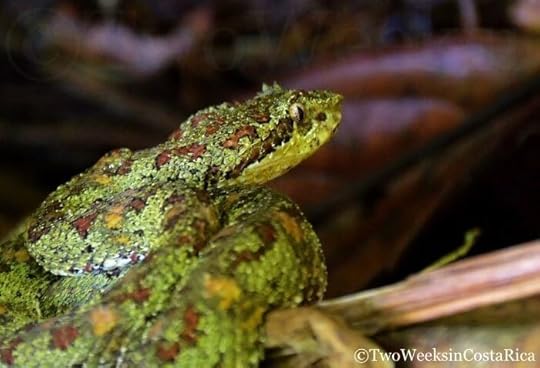
Eyelash Pitviper

Baird’s Tapir
Birds
Aside from animals, we saw a ton of birds too. We visited Sirena with our friend Ann Becker of Travel with Ann, and since we’re all birding enthusiasts, we had our guide focus on birds. We ended up with a laundry list of over 20 different birds. Some of our most memorable species were the Red-capped Manakin, Green Kingfisher, Great Tinamou, Crested Guan, several Scarlet Macaw Parrots, and a gorgeous crested owl.

Crested Owl
Fast Facts About Day Trips to Sirena Ranger Station
Duration: Tours typically run from 6 a.m. to around 1 p.m.
Cost: $80-90 per person, includes round-trip transportation by boat and lunch
Boat Ride: Boats to Sirena are smaller, generally holding around 15-20 passengers. They have a Bimini or hard top that provides protection from the sun. The ride out to Sirena takes a little over 1 hour.
Trail Conditions: The trails are well maintained but rugged. The sections that you’re likely to visit on a day trip are mostly flat and good for most levels, but there are some steeper areas.
Booking a Tour: Be sure to book your tour in advance if you are visiting during the busy dry season (December through April). A guide we highly recommend is Javier from Discovering Corcovado with Javier or you can ask your lodge for a recommendation.
What to Bring
Poncho or light rain jacket: Sirena is located in one of the wettest areas of Costa Rica and rain is frequent. It even rained on our most recent visit last February, during the dry season. A light jacket is also nice to have for the early morning boat ride as it is cool out on the ocean.
Hiking boots
Shoes you don’t mind getting wet: The boats pull up right onshore, so you’ll have to wade through the shallow water to get on and off. Depending on the tide, you might have to walk on rough coral at Sirena so water shoes or something sturdy like Keens are perfect.
Insect Repellent: Mosquitos and other biting insects are a common nuisance in the rainforest. One of our favorite repellents for Costa Rica is Repel’s Deet-free Lemon Eucalyptus. Here’s another link to some more good travel-sized options.
Long Pants: Lightweight, long pants that dry quickly like these ones are best for the hike to Sirena. We wore shorts on our recent visit and ended up finding ticks on ourselves after.
Water: Be sure to pack plenty of water. While you’ll be under the cover of the rainforest canopy most of the time, temperatures can still reach the 90s F (32° C) with a lot of humidity.

Beach landing at Sirena
If you’re coming to Costa Rica to see wildlife, Sirena Ranger Station is one of the best places to visit. It is an easy day trip from Drake Bay and will give you the opportunity to see some of the country’s rarest animals and birds. Not only that, but you’ll get to experience the rawest jungle that the country has to offer.
Have a question about visiting Sirena Ranger Station? Ask us in the comments below.
Want more information to plan your trip to Drake Bay? Check out these articles:
Drake Bay: Costa Rica Unplugged – Detailed guide to visiting this popular, but quaint, village. Where to stay, what to do, and more.
A Night Tour with Tracie the Bug Lady – One of Drake Bay’s most popular tours that will show you what lurks in the jungle by night.
A Hike to Playa San Josecito – If you’re up for a long hike, you won’t want to miss the beautiful San Josecito Beach for swimming and snorkeling.
Packing for Costa Rica: The Essentials – Tips for what to bring on your trip, including specific recommendations for Drake Bay.
The post Spotting Costa Rica’s Most Spectacular Wildlife at Sirena Ranger Station appeared first on Two Weeks in Costa Rica.



